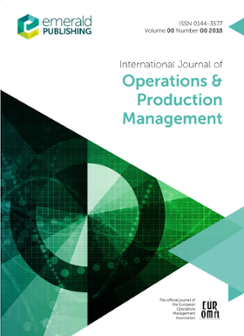Recovery from plant-level supply chain disruptions: supply chain complexity and business continuity management
IF 7.4
2区 管理学
Q1 MANAGEMENT
International Journal of Operations & Production Management
Pub Date : 2023-04-20
DOI:10.1108/ijopm-09-2022-0611
引用次数: 1
Abstract
Purpose The purpose of our study is to investigate how a manufacturing plant’s internal operations along with its network of connections (upstream and downstream) can have an impact on its recovery time from a disruption. The authors also examine the inverse-U impact of complexity. Finally, the authors test the moderating role that business continuity management plans (BCP) at the plant level have on recovery time. Design/methodology/approach To test our hypotheses, the authors partnered with Resilinc Corporation, a Silicon Valley-based provider of supply chain risk management solutions to identify focal firms’ suppliers, customers and plant-level data including information on parts, manufacturing activities, bill of materials, alternate sites and formal business continuity plans. The authors employed censored data regression technique (Tobit). Findings Several important findings reveal that the plant’s internal operations and network connections impact recovery time. Specifically, the number of parts manufactured at the plant as well as the number of internal plant processes significantly increase disruption recovery time. In addition, the number of supply chains (upstream and downstream) involving the plant as well as the echelon distance of the plant from its original equipment manufacturer significantly increase recovery time. The authors also find that there exists an inverted-U relationship between complexity and recovery time. Finally, the authors find partial support that BCP will have a negative moderating effect between complexity and recovery time. Originality/value This research highlights gaps in the literature related to supply chain disruption and recovery. There is a need for more accurate methods to measure recovery time, more research on recovery at the supply chain site level and further analysis of the impact of supply chain complexity on recovery time.从工厂级供应链中断中恢复:供应链复杂性和业务连续性管理
我们研究的目的是调查制造工厂的内部运营及其连接网络(上游和下游)如何影响其从中断中恢复的时间。作者还研究了复杂性的反u型影响。最后,作者检验了工厂层面的业务连续性管理计划(BCP)对恢复时间的调节作用。为了验证我们的假设,作者与硅谷供应链风险管理解决方案提供商Resilinc公司合作,确定重点公司的供应商、客户和工厂级数据,包括零件信息、制造活动、物料清单、备用地点和正式的业务连续性计划。作者采用了删节数据回归技术(Tobit)。几个重要的发现揭示了工厂的内部操作和网络连接影响恢复时间。具体来说,工厂制造的零件数量以及工厂内部流程的数量显著增加了中断恢复时间。此外,涉及工厂的供应链(上下游)数量以及工厂与原始设备制造商的梯队距离显著增加了恢复时间。研究还发现,复杂程度与恢复时间呈倒u型关系。结果表明,BCP在复杂性与恢复时间之间存在负向调节作用。独创性/价值本研究突出了与供应链中断和恢复相关的文献中的空白。需要更精确的测量恢复时间的方法,需要更多的供应链现场层面的恢复研究,需要进一步分析供应链复杂性对恢复时间的影响。
本文章由计算机程序翻译,如有差异,请以英文原文为准。
求助全文
约1分钟内获得全文
求助全文
来源期刊
CiteScore
13.30
自引率
17.20%
发文量
96
期刊介绍:
The mission of the International Journal of Operations & Production Management (IJOPM) is to publish cutting-edge, innovative research with the potential to significantly advance the field of Operations and Supply Chain Management, both in theory and practice. Drawing on experiences from manufacturing and service sectors, in both private and public contexts, the journal has earned widespread respect in this complex and increasingly vital area of business management.
Methodologically, IJOPM encompasses a broad spectrum of empirically-based inquiry using suitable research frameworks, as long as they offer generic insights of substantial value to operations and supply chain management. While the journal does not categorically exclude specific empirical methodologies, it does not accept purely mathematical modeling pieces. Regardless of the chosen mode of inquiry or methods employed, the key criteria are appropriateness of methodology, clarity in the study's execution, and rigor in the application of methods. It's important to note that any contribution should explicitly contribute to theory. The journal actively encourages the use of mixed methods where appropriate and valuable for generating research insights.

 求助内容:
求助内容: 应助结果提醒方式:
应助结果提醒方式:


